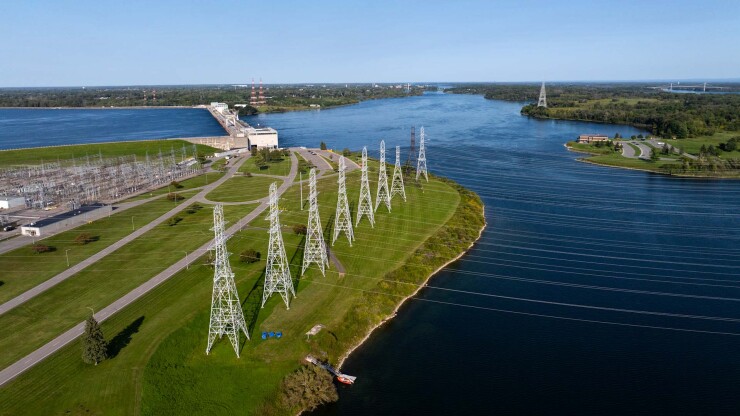
The New York Power Authority priced a very complicated deal this year, in service of a very simple goal: saving 10% for its customers.
NYPA spent two years creating a new conduit issuer to issue the first prepaid energy deal ever priced in New York. The deal achieved the 10% savings the authority hoped to achieve, and is honored as The Bond Buyer's
"Having this entity set up was a major undertaking. People had to be convinced," NYPA Chief Financial Officer Adam Barsky said.
"Is it necessary? Why should we be doing this? Why can't this go somewhere else? We had to make all those arguments as to why create this entity," he said.
"To have its first deal out of the box [win] Deal of the Year, it validates the fact that there was a real reason to have this new entity created," Barsky said.
The $
The deal was structured as term bonds due in 2056, callable in 2033. The deal was rated A1 by Moody's Ratings.
NYPA didn't have to create a conduit issuer for the deal — technically, NYPA didn't have to use a conduit issuer at all, according to Yamini Kalidindi, vice president of NYPA's portfolio management office.
"What the conduit helps facilitate is it takes it off balance sheet, completely off credit. We are in no part responsible for paying the debt," said Kalidindi, who led the transaction. "Our only obligation is to pay for the power that we receive. We have no other fixed obligations related to it."
To create the NYEFDC, NYPA had to win the support of Empire State Development and New York Gov. Kathy Hochul, Barsky said. The authority also had to navigate "electric regulatory rules, turbulent markets, and the needs of stakeholders," according to its nominating statement for the award.
Last year, when the Long Island Power Authority entered a prepaid electricity transaction, it used a conduit issuer in Alabama, the
"When you do these deals through these entities, they all charge a fee," Barsky said. "So the first thing was, well, why are we having some entity in Alabama getting this fee to help Alabama? At least, if people are going to be paying fees, have the fees go to a New York entity that's going to go and use that money to further economic development."
Using a New York conduit also heightened the bonds' appeal to a certain slice of the market, Barsky said.
"When you are able to do this in New York versus Alabama, A, you're getting the triple tax exemption and B, the demand in the New York investor universe for New York-related paper," Barsky said.
Once the deal was finally ready, it was delayed for several months due to
"It took the savings related to the deal out of the market, and we weren't going to get 10%. And we refused to do it for anything less," Barsky said. "So we went to the sidelines, and we sat and waited and monitored the market."
The deal team jumped at the opportunity to issue in July, once market conditions were more favorable for prepay deals.
Ultimately, NYPA earned 10.1% savings, exceeding its target, Kalidindi said. The bonds had a 4.53% yield and were oversubscribed, Barsky said.
In an interview
"We had people putting in orders for over $100 million at a shot, buying up significant chunks of the deal, because they knew that it was new, different and an opportunity to diversify their portfolios," Barsky said. "There's a scarcity effect there that really helped and made a big difference."
The deal's savings target was aligned with New York's priorities, Barsky said. Like many Northeast states, New York's lawmakers are very concerned with the cost of living, and with affordable electricity prices in particular.
The deal will also allow NYPA to further New York's clean energy goals through power purchase agreements with developers for green energy projects. Solar projects from New York City's Department of Citywide Administrative Services and the Port Authority of New York and New Jersey will be major beneficiaries of the PPAs.
According to the deal's preliminary offering statement, "the potential power purchase agreements are expected to make up no more than 25% of the delivery obligations."
The NYEFDC could benefit NYPA and other issuers in the state in the future, Barsky said. Eventually, NYPA aims to create one gigawatt of nuclear power, and reducing costs through a prepay could play a significant role in those plans.
The deal's structure is complex, but typical of prepay electricity bonds
"There's a limited number of buyers of this type of transaction in the marketplace, because it's a little esoteric," Barsky said.
NYEFDC applies the bond's proceeds to Aron Energy Prepay 47 LLC, the deal's "electricity supplier." Aron is a subsidiary of Goldman Sachs, the lead bond underwriter.
Aron Energy Prepay will deposit roughly the same amount of funds to Athene Annuity and Life Company, the deal's funding recipient. Athene Annuity will return the funds to Aron Energy Prepay in installments matching the purchase obligations over the course of 30 years.
Aron Energy Prepay will procure the electricity from J. Aron, paying monthly in arrears. J. Aron's payment obligations are guaranteed by Goldman Sachs. Then, Aron Energy Prepay will deliver the electricity to NYEFDC, which will sell the electricity to NYPA at a predetermined price.
Prepays are a
There were more than
Energy prepays have also been recognized in the Bond Buyer Deal of the Year awards; last year, the
The New York Power Authority won Northeast Deal of the Year in 2020 for a
Academy Securities, Ramirez, Siebert Williams Shank and Wells Fargo were co-managers on the prepay deal. PFM and Hilltop Securities were co-municipal advisors, and Nixon Peabody and HLF were co-counsels. Orrick, Herrington & Sutcliffe was counsel to NYPA and Katten Muchin Rosenman was underwriter's counsel.
Mohanty Gargiulo LLC also advised, according to the nominating statement.
RBC is the commodity swap counterparty.





